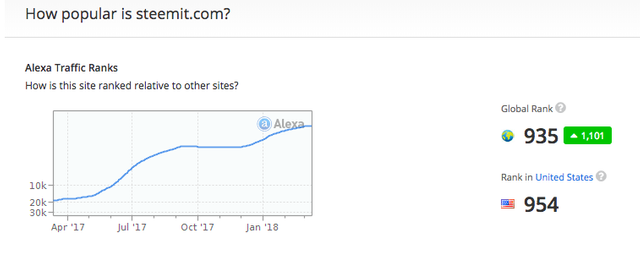Steemit Review: How Does It Work and Can You Really Earn From It?
The brain-child of Daniel Larimer, founder of BitShares, and Ned Scott, a former financial analyst, Steemit is a blockchain-based social media platform modeled loosely on Reddit.Anyone who uses Reddit knows that content lives and dies with the sacred upvote (or downvote). Upvotes bring “karma,” greater visibility, and even the chance of landing on the front page. Similarly, Steemit users are vying for upvotes, but this is because engagement and attention lead to actual financial reward. Steemit rewards users for posting, commenting, and even just upvoting other content. Rewards are paid in the platform’s native cryptocurrency, STEEM. To describe it using their own words:
Steemit has redefined social media by building a living, breathing, and growing social economy – a community where users are rewarded for sharing their voice. It’s a new kind of attention economy.
Steemit has been around since July 2016, it has a significant number of users, and it’s currently the 27th biggest cryptocurrency by market cap. Yet there doesn’t seem to be much of a verdict on this platform (at least in a broad sense). In this article, we assess the platform on how it works, how to use it and if you can really earn money from Steemit.
How Steemit Works
Steemit, Inc. is a privately held company based in New York City. So behind this blockchain platform is a private company, not a random group of developers as is often the case. Compared to some of its blockchain bretheren, Steemit is relatively simple.
Here is a video overview:
Cryptocurrencies & Platforms Featured
Steemit Review: How Does It Work and Can You Really Earn From It?
March 20, 2018 By Colin Adams
2The brain-child of Daniel Larimer, founder of BitShares, and Ned Scott, a former financial analyst, Steemit is a blockchain-based social media platform modeled loosely on Reddit.Anyone who uses Reddit knows that content lives and dies with the sacred upvote (or downvote). Upvotes bring “karma,” greater visibility, and even the chance of landing on the front page. Similarly, Steemit users are vying for upvotes, but this is because engagement and attention lead to actual financial reward. Steemit rewards users for posting, commenting, and even just upvoting other content. Rewards are paid in the platform’s native cryptocurrency, STEEM. To describe it using their own words:
Steemit has redefined social media by building a living, breathing, and growing social economy – a community where users are rewarded for sharing their voice. It’s a new kind of attention economy.
Steemit has been around since July 2016, it has a significant number of users, and it’s currently the 27th biggest cryptocurrency by market cap. Yet there doesn’t seem to be much of a verdict on this platform (at least in a broad sense). In this article, we assess the platform on how it works, how to use it and if you can really earn money from Steemit.
How Steemit Works
Steemit, Inc. is a privately held company based in New York City. So behind this blockchain platform is a private company, not a random group of developers as is often the case. Compared to some of its blockchain bretheren, Steemit is relatively simple. Here is a video overview:Steemit.com is only one platform for blogs and social media content that sits atop the Steem blockchain. There are other platforms that use the same blockchain and underlying economic mechanisms. An example of this is D.tube, a decentralized video platform based on the InterPlanetary File System protocol. D.tube is YouTube without the advertisements (and user base) – instead, it uses the built-in Steem currency to reward content producers. D.sound is another example, in this case for audio streaming.The entire Steem system is built on secure blockchain software that runs on a network of computers. At the root of the platform is the currency STEEM, which is your typical transferrable, fungible, freely moveable token (similar to bitcoin). The currency comes in 3 variants.
- Steem (STEEM) – Steem is the fundamental unit of account on the Steem blockchain. All other tokens derive their value from the base value of STEEM. STEEM is liquid and can be sought, sold, or exchanged in any way a holder sees fit. STEEM can be converted to both Steem Power and Steem Dollars. Turning STEEM into STEEM Power is referred to as “powering up.” The current inflation rate of STEEM is 9%, and it will decrease by 0.5% every year until the rate reaches 0.95%.
- Steem Power (SP) – STEEM that has been committed to a 13-week vesting schedule is referred to as Steem Power (SP). SP has a 2-pronged intent; it creates an incentive mechanism where holders take a long-term interest in the project, and by having Steem Power it increases an account’s voting weight (and by extension its ability to be further rewarded). A win–win for both users and for the ecosystem as whole. SP is illiquid, and it can be thought of as network equity. When a user decides to convert SP back into STEEM, it is referred to as “powering down.”
- Steem Dollars (SD) – SD are a debt-like instrument, pegged to the US dollar, that promise to distribute US$1 worth of STEEM per SD to the token holder at some point in the future. You can trade Steem Dollars with STEEM, or transfer them to other accounts for commerce or exchange. The aim here is to provide a vehicle to lend the community money and, ultimately, to foster growth.
The Steem blockchain is consistently minting new STEEM tokens and adding them to a community “rewards pool.” The STEEM is then awarded to users for their contributions, based on the votes that their content receives. Create valuable content and get rewarded, so the theory goes. With every new block, 15% of the new STEEM units are awarded to the people who hold Steem Power, 75% are handed off to content creators, and 10% of the new Steem units are paid to miners.When you create content that actually earns money, 50% is paid to you in Steem Dollars that can be exchanged for actual money right away. The other 50% is paid in Steem Power. The Steem Power Units are locked in the vesting period mentioned above. The phrase “minting” might have made you think of cryptocurrency mining or forging processes, like ones found on many other blockchains. STEEM is a mineable currency, but it’s not the primary way of earning tokens. Producing or interacting with content on Steemit is the main way for users to get STEEM. You can, of course, also purchase Steem on an exchange or earn interest (a very small amount) by holding SP. The Steemit platform has grown immensely since its inception. Here’s how the traffic on Steem grew in the last year, according to Alexa’s web ranking:

To delve deeper into Steemit’s technical details, you can read the whitepaper or browse their FAQ.
Can You Really Earn on Steemit?

Now that we’ve understood the basics of how Steemit functions, the next question is: does it work from a content producer’s perspective? The short answer is yes, but there’s a lot more to it than that. Before we delve further into Steemit’s merit as a content platform or investment vehicle, it’s worth noting there are some question marks regarding Steem’s launch. One article alleges that the initial distribution process of tokens was rigged and that Steem is not truly a decentralized network (Dash, anyone?). Whether or not this is true remains debatable – read the article and draw your own conclusions.
Hi! I am a robot. I just upvoted you! I found similar content that readers might be interested in:
https://www.investinblockchain.com/steemit-review/
This post has been submitted for the @OriginalWorks Sponsored Writing Contest!
You can also follow @contestbot to be notified of future contests!